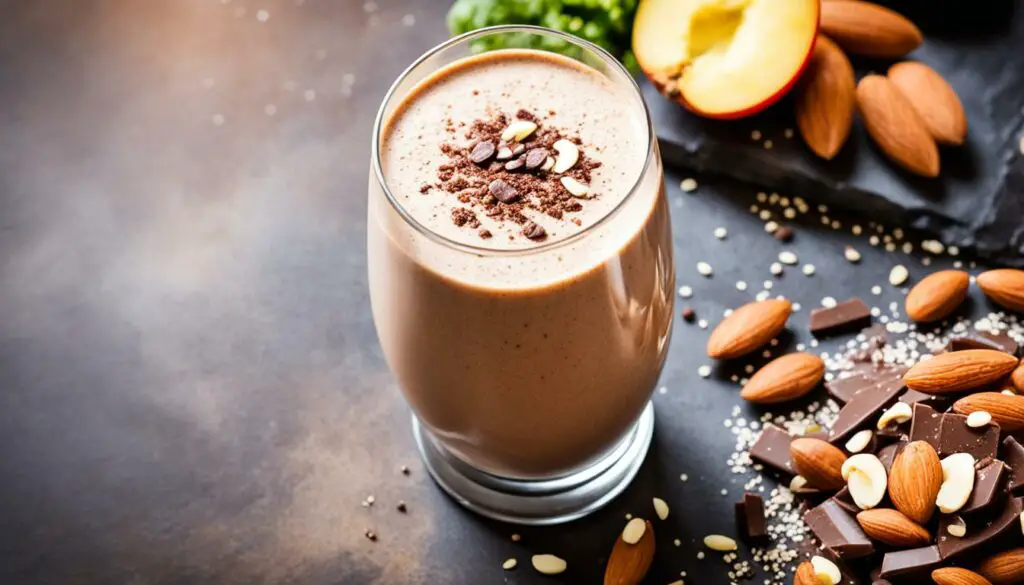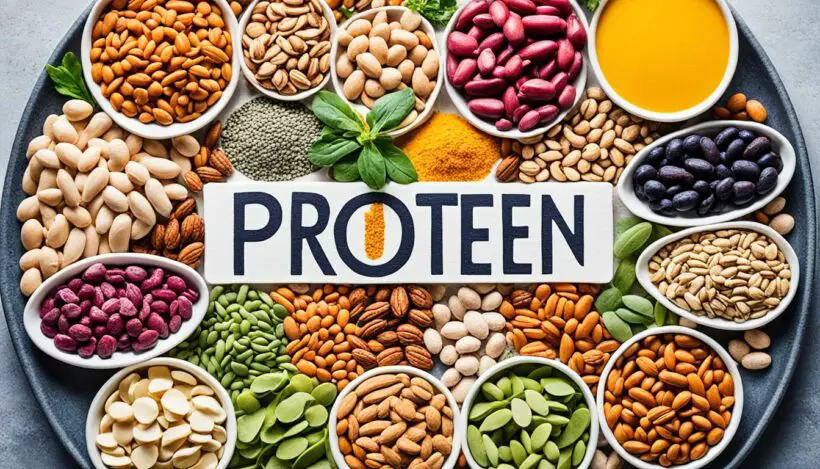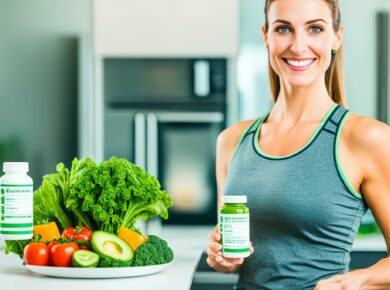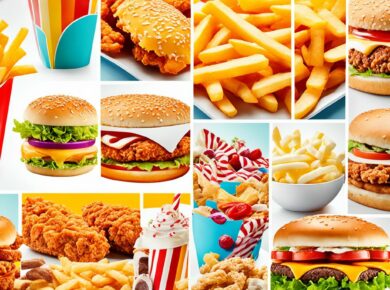Are you looking to add more protein to your diet? Incorporating protein-rich foods into your meals is a simple and effective way to meet your protein needs. Whether you’re following a high-protein diet, looking for the best sources of protein, or wanting protein-packed recipes, there are plenty of options available for everyone.
Protein is essential for a balanced diet and offers numerous health benefits. Not only does it promote weight loss and enhance muscle growth, but it also plays a crucial role in overall health. From lean protein foods to vegetarian protein sources and plant-based proteins, you have a variety of choices to suit your dietary preferences and goals.
If you’re interested in exploring different protein sources, stay tuned for this article! We will provide valuable insights and tips on incorporating protein-rich foods into your daily routine. Packed with information, we will cover topics such as starting your meals with protein, snacking on protein-rich foods, and even replacing cereal with protein-rich alternatives. There’s something for everyone to enjoy.
So, if you’re ready to take your protein intake to the next level, keep reading. We’re about to dive into a world of protein-rich deliciousness!
Start with Protein First
When it comes to mealtime, make sure to prioritize your protein source. Not only will this help keep you fuller for longer, but it can also have a positive impact on your blood sugar and insulin levels. By consuming protein before any other components of your meal, you can regulate the release of the hunger hormone, ghrelin, and prevent dramatic fluctuations in blood sugar. In fact, a study conducted on individuals with type 2 diabetes found that consuming protein and vegetables before high-carb foods resulted in significantly lower blood sugar and insulin spikes.
If you’re aiming to manage your weight or simply maintain a balanced diet, starting your meals with a protein-rich food can be a game-changer. By doing so, you can promote satiety, reduce the likelihood of overeating, and support overall health. So, make it a habit to opt for protein sources such as lean meats, fish, poultry, eggs, legumes, or soy products at the start of your meals.
Combining protein with other nutritious foods like vegetables or whole grains can provide a well-rounded, satisfying meal. Additionally, the consumption of protein-rich foods triggers the release of the hormone peptide YY, which sends signals to the brain to signal fullness.
The key takeaway here is that incorporating protein first in your meals can help you stay full, regulate hunger hormones, and maintain steady blood sugar and insulin levels. So, remember to start with protein to maximize the benefits for your body and overall well-being.
Snack on Protein-Rich Cheeses
When it comes to snacking, many common options lack the protein content your body needs. However, there’s a delicious solution to this problem – cheese! Snacking on protein-rich cheeses can significantly increase your overall protein intake while satisfying your taste buds.
Take cheddar cheese, for example. With 7 grams of protein per 1-ounce serving, it’s a convenient and tasty way to incorporate more protein into your diet. Plus, cheese provides additional nutritional benefits, such as calcium, which is essential for maintaining healthy bones and teeth.
But that’s not all! Some studies even suggest that cheese may have a positive impact on heart health. So you can enjoy your cheese guilt-free, knowing that you’re supporting your cardiovascular well-being, too.
For a satisfying and protein-packed snack, pair your cheese with whole grain crackers for added fiber, or enjoy it with sliced tomatoes or apples for a refreshing twist. This combination not only enhances the taste but also provides a balanced and nutritious snack option.
- High in protein
- Source of calcium
- Potential heart health benefits
- Pair with whole grain crackers, tomatoes, or sliced apples
Replace Cereal with Protein-Rich Eggs
Are you tired of starting your day with a breakfast that leaves you feeling hungry soon after? It’s time to swap out that low-protein cereal for a more satisfying and nutritious option – eggs. Eggs are a high-protein breakfast staple that can significantly boost your protein intake and keep you satiated throughout the morning.
Three large eggs provide a whopping 19 grams of protein, along with important nutrients like selenium and choline. Not only are eggs a great source of protein, but they also offer a range of other health benefits. By replacing your cereal with eggs, you can kickstart your day with a protein-packed meal that will keep you energized and full for longer.
Research has shown that eating eggs for breakfast can have a positive impact on appetite control. A study published in the International Journal of Obesity found that participants who consumed eggs for breakfast experienced greater feelings of fullness and reduced calorie intake throughout the day compared to those who ate a cereal-based breakfast.
Eggs are not only delicious and versatile but also a cost-effective way to incorporate high-quality protein into your diet. They can be prepared in various ways – boiled, scrambled, or as an omelet – making them suitable for any taste preference or dietary requirement.
Benefits of Eggs for Breakfast
- Increased feelings of fullness
- Reduced calorie intake throughout the day
- A good source of high-quality protein
- Important nutrients like selenium and choline
- Versatile and can be prepared to suit any taste preference
So the next time you reach for that box of cereal or packet of oatmeal, think about the protein-packed possibilities of eggs. Start your day with a satisfying and nutritious high-protein breakfast that will not only keep you full but also support your overall health and well-being.
Add Chopped Almonds for Extra Protein
Almonds are a nutritious and protein-rich food. A 1-ounce serving of almonds contains 6 grams of protein, making them a great addition to increase the protein content of your meals and snacks. They are also high in magnesium, fiber, and heart-healthy monounsaturated fats. Adding chopped almonds to yogurt, cottage cheese, salads, or oatmeal can provide an extra boost of protein and add a delicious crunch to your dishes.
Almonds are not only a tasty snack but also a fantastic source of protein. Incorporating them into your meals and snacks can help boost your daily protein intake. In addition to protein, almonds are rich in magnesium, fiber, and healthy monounsaturated fats. Adding chopped almonds to your favorite dishes is an easy way to add a nutritious crunch and increase your protein content.
- Boost protein content: A 1-ounce serving of almonds contains 6 grams of protein, making them an excellent source of plant-based protein.
- Rich in magnesium: Almonds are high in magnesium, an essential mineral that plays a crucial role in various bodily functions, including muscle and nerve function.
- Increase fiber intake: Almonds are a good source of dietary fiber, which can promote digestive health and help maintain healthy blood sugar levels.
- Heart-healthy fats: Almonds are rich in monounsaturated fats, which can help reduce bad cholesterol levels and lower the risk of heart disease.
- Versatile addition: Chopped almonds can be sprinkled over yogurt, cottage cheese, salads, or oatmeal to add a protein-rich crunch to your favorite dishes.
By incorporating chopped almonds into your meals and snacks, you can easily add protein, magnesium, fiber, and healthy fats to your diet. Enjoy the nutritional benefits and delicious taste of almonds while enhancing your overall health.
Choose Greek Yogurt for Protein Power
Greek yogurt is a versatile and protein-packed food that can be a beneficial addition to your diet. Compared to regular yogurt, Greek yogurt contains twice the amount of protein, making it an excellent choice for those looking to increase their protein intake.
A 3.5-ounce serving of Greek yogurt provides 10 grams of protein, which can help support muscle growth and repair. Protein is also known to promote feelings of fullness by releasing hunger hormones. This can be particularly beneficial for those trying to manage their weight or reduce calorie intake.
Furthermore, Greek yogurt contains conjugated linoleic acid (CLA), which is a type of fatty acid known for its potential fat loss properties. While more research is needed to fully understand CLA’s effects on weight loss, incorporating Greek yogurt into your diet can be a healthy addition to support your health and fitness goals.
You can enjoy Greek yogurt in various ways. Add some fresh berries for a burst of flavor and extra antioxidants. Substitute Greek yogurt for sour cream in recipes to reduce fat content and increase protein. You can also incorporate Greek yogurt into smoothies, parfaits, or use it as a creamy topping for savory dishes. The possibilities are endless!
Including Greek yogurt in your daily routine is an easy and delicious way to boost your protein intake while enjoying its many health benefits. Whether as a quick snack, breakfast, or ingredient in your favorite dishes, Greek yogurt provides a satisfying dose of protein and essential nutrients.
Boost Protein with a Shake
Protein shakes are an easy and convenient way to increase your protein intake. They are especially popular among fitness enthusiasts and those looking to build muscle. One of the most commonly used protein powders is whey protein powder. Whey powder is derived from milk and contains a high concentration of protein. It is easily absorbed by the body and provides all the essential amino acids that your body needs.
With just one scoop of whey powder, you can add approximately 17 grams of protein to your shake. This makes it an excellent choice for a post-workout snack or a quick breakfast on busy mornings. To create a nutritious and protein-rich shake, mix the whey powder with unsweetened almond milk, fresh berries, and other healthy ingredients. You can also experiment with different flavors and add-ins such as unsweetened nut butter, flaxseeds, or chia seeds to further enhance the protein content of your shake.
Protein shakes not only provide an additional source of protein, but they can also help increase satiety. The high protein content can help you feel full and satisfied, making it easier to resist unhealthy snacks and stick to your dietary goals. Incorporating protein shakes into your diet can be a convenient and efficient way to meet your protein needs, especially if you have a busy or active lifestyle.

Additional Protein Sources for Your Shake:
- Almond butter
- Soy milk
- Greek yogurt
- Collagen peptides
- Plant-based protein powders
Include High-Protein Foods in Every Meal
To meet your protein needs, aim to include a high-protein food in every meal. Adding these protein-rich options will ensure you’re getting the nutrients your body needs for optimal health. There are several high-protein foods you can choose from:
- Meat: Incorporate lean cuts of beef, pork, or lamb into your meals. These meats are not only rich in protein but also provide essential vitamins and minerals.
- Fish: Opt for fatty fish like salmon, trout, or sardines. These fish are not only excellent sources of protein but also contain omega-3 fatty acids, which are beneficial for heart health.
- Poultry: Enjoy poultry options such as chicken or turkey. These meats are lean and high in protein, making them a healthy choice for your meals.
- Eggs: Include eggs in your diet as they are a versatile and protein-packed option. Whether you prefer them scrambled, boiled, or as an ingredient in various dishes, eggs are an excellent source of protein.
- Legumes: Add legumes like lentils, chickpeas, or black beans to your meals. These plant-based proteins are not only high in protein but also rich in fiber, vitamins, and minerals.
- Soy products: Consider incorporating soy-based products like tofu or tempeh into your meals. They are complete sources of protein and provide essential amino acids.
By consuming 30-40 grams of protein at each meal, you’ll promote fullness and preserve muscle mass more effectively than if you consume smaller amounts throughout the day. Explore the variety of high-protein foods available and create a balanced and protein-rich diet that suits your preferences and lifestyle.
Lean Cuts of Meat and Protein
When it comes to boosting the protein content of your meals, choosing lean cuts of meat is a smart move. Lean meats, such as sirloin steak, offer more protein with fewer calories compared to fattier cuts. For example, a 3-ounce serving of sirloin steak contains 26 grams of protein and 150 calories, while the same serving of T-bone steak provides 21 grams of protein and 250 calories. By opting for lean cuts of meat, you can increase your protein consumption while keeping your calorie intake in check.
Lean meat refers to cuts that have less fat marbling and lower overall fat content. These cuts typically include skinless poultry, lean beef, pork tenderloin, and certain types of seafood. The protein content of lean meats can vary, so it’s important to check the nutrition labels or reference a reliable source to determine the protein content per serving.
In addition to choosing lean cuts of meat, slightly increasing portion sizes can also contribute to a higher protein intake. However, it’s crucial to practice portion control and consider your overall calorie goals when adjusting portion sizes. You don’t want to overconsume calories while aiming to increase protein consumption.
By incorporating lean cuts of meat and paying attention to portion sizes, you can effectively boost the protein content of your meals without sacrificing taste or exceeding your desired calorie intake. Remember to consult with a healthcare professional or registered dietitian if you have specific dietary concerns or restrictions.
Conclusion
Incorporating protein-rich foods into your diet is essential for maintaining overall health and well-being. Protein offers a range of health benefits, such as supporting muscle growth, promoting satiety, and stabilizing blood sugar levels. By following the suggestions in this article, such as starting your meals with protein and snacking on protein-rich foods, you can easily increase your protein intake.
It’s important to remember to incorporate a variety of protein sources into your diet to ensure a balanced and protein-rich eating plan. This can include options like lean meats, fish, poultry, eggs, legumes, and soy products. By doing so, you can optimize your nutrition and reap the advantages of a well-rounded diet.
So, start incorporating protein-rich foods into your daily meals and snacks, and strive for a balanced diet that includes a variety of protein sources. By doing this, you can enjoy the health benefits of protein intake and support your overall well-being.






